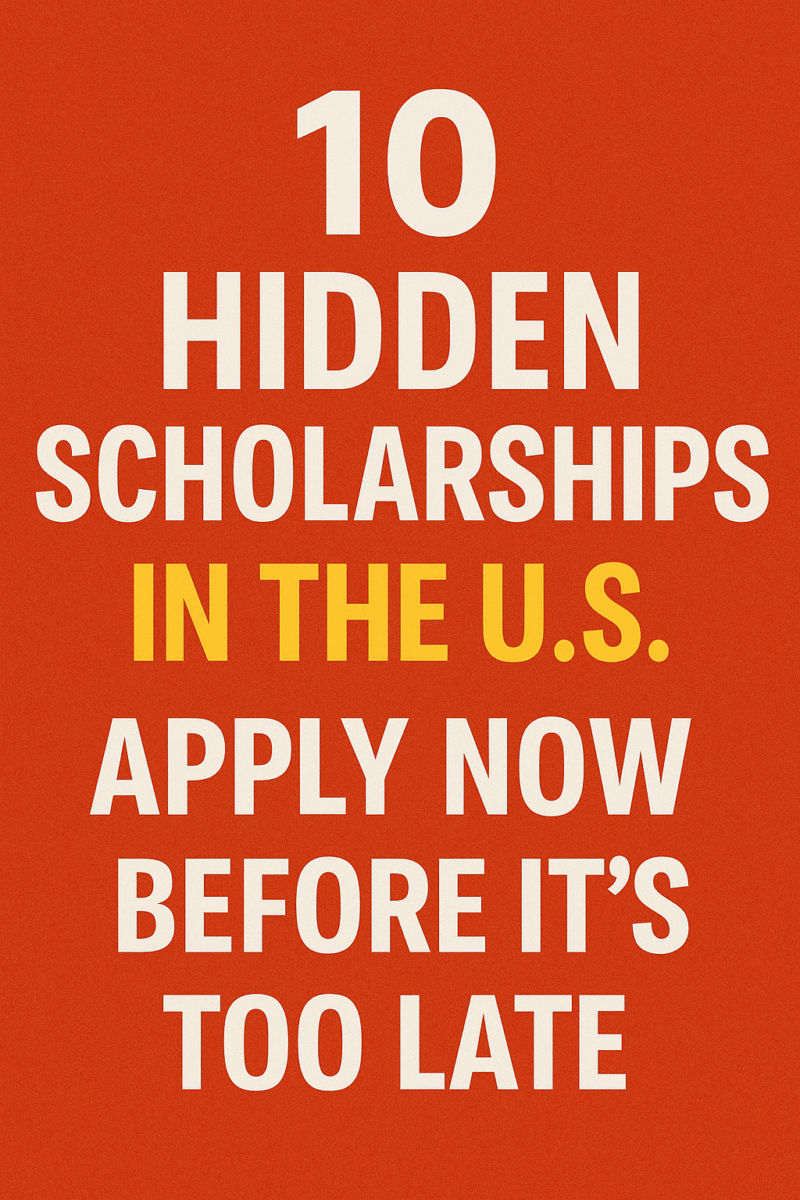Outline
-
Introduction: Why Hidden U.S. scholarships Matter
-
The Truth About “Hidden” U.S. scholarships
-
Scholarship 1 – The Zolp Scholarship (full story, real winners, application guide)
-
Scholarship 2 – Tall Clubs International (history, tips, deadlines)
-
Scholarship 3 – The Asparagus Club Scholarship (career pathway analysis)
-
Scholarship 4 – Duct Tape Stuck at Prom Contest (creativity strategies, past winners’ designs)
-
Scholarship 5 – Klingon Language Institute (for language/linguistics students)
-
Scholarship 6 – National Potato Council Scholarship (STEM and agriculture focus)
-
Scholarship 7 – Vegetarian Resource Group Scholarship (activism + lifestyle)
-
Scholarship 8 – American Fire Sprinkler Association (essay-writing hack)
-
Scholarship 9 – Duck Calling Contest (unique hobbies → money)
-
Scholarship 10 – Left-Handed Students Awards (history, why they exist)
-
Hidden U.S. scholarships for Minorities & Immigrants (HSF, UNCF, Dream.US, APIA)
-
Local and Community-Based Hidden Scholarships (churches, rotary, regional funds)
-
Case Studies: Real Students Who Won
-
Essay-Writing Tips to Win Hidden Scholarships
-
Common Mistakes Students Make When Applying
-
Step-by-Step: How to Find Hidden U.S. scholarships Near You
-
Deadlines & Application Strategy (Table Comparison)
-
Why You Should Apply Now, Not Later
-
Conclusion: Unlock Your Hidden Opportunity
-
5 Unique FAQs
Hidden U.S. Scholarships You Never Knew Existed – Apply Before It’s Too Late
Introduction: Why Hidden U.S. Scholarships Are the Best Kept Secret
Discover hidden U.S. scholarships you never knew existed! From quirky contests to minority-focused awards, learn how to apply before deadlines close and secure free money for college today.
Every year, millions of dollars in U.S. scholarships go unclaimed. Why? Because many of them are quirky, unusual, or “hidden” in plain sight. Most students only apply for the big ones, the Gates Millennium, Fulbright, Rhodes, but these attract tens of thousands of applicants.
Now picture this: A scholarship worth $5,000 where only 200 people apply. Suddenly, the odds are in your favor. These hidden U.S. scholarships don’t make headlines, but they can change your life by funding tuition, books, or even living expenses.
This post is your insider guide. I’ll take you through real U.S. scholarships you’ve probably never heard of, explain who qualifies, how to apply, and why these opportunities are too good to miss.
So grab a pen, you’re about to uncover the hidden U.S. scholarships that no one talks about, but everyone should.
See Also: Top 10 U.S. Fully Funded Scholarships for International Student
The Truth About “Hidden” U.S. scholarships
The word “hidden” doesn’t mean secret. These scholarships are publicly available, but they don’t get the same PR attention as mainstream awards. Here’s why they stay under the radar:
-
Niche Eligibility: Many scholarships are tied to unusual factors, your last name, your height, or even your favorite vegetable.
-
Local Focus: Some U.S. scholarships are community-based and only promoted in small circles like rotary clubs or county boards.
-
Minimal Marketing: Unlike big national awards, hidden U.S. scholarships don’t have massive advertising budgets.
Why Hidden U.S. scholarships = Higher Chances
Let’s compare:
| Scholarship Type | Applicants | Award Amount | Odds of Winning |
|---|---|---|---|
| Rhodes | 2,500+ | Full ride | Less than 1% |
| Duct Tape Contest | 500 | $10,000 | 5–10% |
| Local Rotary Award | 100 | $2,000 | 10–20% |
See Also: Get hired in Canada in 2026 free Visa Sponsored Jobs
When you aim for “hidden” awards, you’re competing against dozens, not thousands. That’s why the smartest students apply here first.
1. The Zolp Scholarship – For Students Named Zolp
Yes, this is a real scholarship. Loyola University Chicago created the Zolp Scholarship exclusively for students whose last name is Zolp.
How It Works
-
Must be Catholic.
-
Must be admitted to Loyola University Chicago.
-
Your legal surname must be Zolp (on both birth certificate and baptismal certificate).
Why It Exists
The scholarship was endowed by a benefactor named Mr. Zolp, who wanted to support future generations of Zolps.
Impact
It may sound funny, but for the few who qualify, it’s essentially a tuition-free ticket to Loyola. In the past, entire Zolp families have benefited.
If you’re not a Zolp, don’t despair. This example shows how hyper-specific scholarships can exist, and all you need to do is find one that matches your profile.
-
Applicants must be Catholic students with the last name “Zolp,” admitted to Loyola University Chicago.
-
After admission (by February 1), apply via LUC Scholarship Connect: available at the official Loyola portal Access Scholarships+15Loyola University Chicago –+15Loyola University Chicago –+15.
2. Tall Clubs International Scholarship – For Tall Students
This scholarship rewards something you had no control over—your height.
Eligibility
-
Women: 5’10” or taller.
-
Men: 6’2” or taller.
-
Must be under 21 and entering college.
Award
Winners receive $1,000 toward tuition.
Why It Matters
Height is rare, and this scholarship embraces it. Tall Clubs International, a social group for tall people, sponsors this to celebrate uniqueness.
Application Tip
The key to winning isn’t just being tall—it’s writing an essay about how your height has shaped your life, confidence, and goals.
Think of this as turning a trait into a story. For example: “I could see over everyone in marching band, but I also learned leadership by standing tall.”
Find application details and requirements on the TCI Foundation site Scholarships.com+11Tall Club Foundation+11Tall Clubs International+11.
3. The Asparagus Club Scholarship – Supporting the Grocery Industry
If you’re headed into a career in the food or grocery business, the Asparagus Club could fund you.
Who Can Apply
-
Students majoring in business, food science, or a related field.
-
Must show interest in the grocery industry.
Award
Up to $8,000, renewable for two years.
Why It’s Overlooked
Students don’t often search for “asparagus scholarships.” Yet this club, founded in 1909, has awarded millions to future food industry leaders.
Hidden Benefit
The grocery industry is massive, stable, and recession-proof. A scholarship here is more than money—it’s a career doorway into retail leadership.
Apply through the NGA Foundation’s portal—open Jan 15 to Apr 15 annually VRG+15Scholarships.com+15BigFuture+15.
4. Duct Tape Stuck at Prom Contest
One of the most creative scholarships in America.
How It Works
-
Create a prom outfit entirely from duct tape.
-
Submit photos online.
-
Judging based on workmanship, originality, and use of colors.
Award
Top winners get $10,000. Runners-up receive smaller prizes.
Success Story
A past winner designed a full ball gown with over 50 rolls of duct tape. She not only won scholarship money but also went viral online, boosting her art portfolio.
Why It’s Smart
This scholarship rewards creativity, not GPA. If you’re crafty, artistic, or just love DIY projects, this could be your golden ticket.
Upload your photo and submission via the Duck Brand “Stuck at Prom” page Axios+8Duck Brand+8Fastw
5. The Klingon Language Institute Scholarship
Yes, Trekkies, it’s real.
Purpose
To promote the study of constructed languages like Klingon and Esperanto.
Eligibility
-
Open to linguistics students or language enthusiasts.
-
Must show engagement with constructed language communities.
Award
Typically $500–$1,500.
Why It Stands Out
Language nerds often get ignored by mainstream scholarships. This one rewards passion, culture, and a love for communication—even in fictional tongues.
Portals vary, but key details are highlighted on scholarship directories and the KLI wiki BigFuture+15Scholarships.com+15Klingon Wiki+15WARREN MOTT COUNSELING+2KLI+2.
6. National Potato Council Scholarship
Potatoes may seem ordinary, but in the U.S. agriculture sector, they’re a billion-dollar industry. The National Potato Council (NPC) offers a scholarship program that’s both generous and specialized.
Who Can Apply
-
Graduate-level students in agriculture or agribusiness.
-
Must demonstrate a research interest benefiting the potato industry.
Award
Up to $10,000 toward tuition and research support.
Why It’s Overlooked
Few students think of potatoes when planning their academic careers. Yet agriculture is one of the most secure job markets—food never goes out of style.
Success Story
One recipient researched sustainable potato farming methods and later worked with major food brands. The scholarship not only funded his degree but also created a clear pathway to a career.
💡 Tip: If you’re pursuing STEM research, never underestimate “crop-specific” scholarships. They look niche, but they carry industry connections that pay off in the long run.
Apply via the Potato LEAF scholarship application page or platforms like Going Merry Potato LEAF+3Potato LEAF+3National Potato Council+3.
7. The Vegetarian Resource Group Scholarship
If you live by your values, this scholarship rewards it. The Vegetarian Resource Group (VRG) offers awards to high school seniors who actively promote a vegetarian or vegan lifestyle.
Award
-
One scholarship of $10,000.
-
Two additional scholarships of $5,000 each.
Criteria
-
Must demonstrate leadership in promoting vegetarianism.
-
Community involvement is key—organizing events, starting clubs, or influencing peers.
Why It’s Unique
Unlike GPA-heavy scholarships, this one looks at your lifestyle and activism. Even starting a blog, podcast, or campus initiative about vegetarianism counts.
👉 Apply directly through the Vegetarian Resource Group’s official page.
💡 Essay Tip: Don’t just say “I’m vegetarian.” Share a story of how your lifestyle inspired others—maybe you organized a meatless Monday event at school, or convinced your family to try plant-based meals.
Download and submit the PDF application form available on the VRG website Fastweb+9VRG+9BigFuture+9.
8. American Fire Sprinkler Association (AFSA) Scholarship
This one is a hidden gem because of how simple it is.
How It Works
-
Read a short essay on fire sprinklers.
-
Take a 10-question quiz.
-
Submit your entry.
Award
-
10 awards of $2,000 each.
-
Open to high school seniors and college students.
Why It’s Overlooked
Students dismiss it because it sounds “too easy.” But that’s exactly why you should apply. Thousands skip it, leaving free money on the table.
Time Investment
Less than 30 minutes. Think about it: half an hour of effort for a shot at $2,000. That’s like getting paid $4,000 per hour for your time.
💡 Pro Tip: Take your time on the quiz. Even if you don’t ace it, you’re still entered into the random drawing.
Access and submit through AFSA’s official Scholarship Contest page VRG+15Fastweb+15Scholarships.com+15
9. The Chick and Sophie Major Memorial Duck Calling Contest
Yes, duck calling is a real skill, and it can fund your education.
Who Can Apply
-
High school seniors across the U.S.
-
Must participate in a duck-calling contest in Stuttgart, Arkansas.
Award
-
First place: $2,000.
-
Runner-up: $1,000.
-
Third place: $750.
-
Fourth place: $500.
Why It’s Special
It celebrates local culture and tradition, while rewarding students for unique hobbies. If you’ve grown up in hunting or wildlife communities, this could be a perfect fit.
Student Story
One winner shared that learning duck calling with his grandfather not only won him a scholarship but also paid tribute to his family’s heritage.
💡 Application Tip: Even if you don’t win first place, just being part of this event helps you stand out in future applications. It shows passion, culture, and creativity.
10. Scholarships for Left-Handed Students
Left-handedness is rare—only about 10% of the population qualifies. Some organizations celebrate this uniqueness by offering scholarships for left-handed students.
Example: Juanita College Left-Handed Scholarship
-
Established by alumnus Mary Francis Beckley.
-
Awarded annually to left-handed students with financial need.
Award
Varies, but typically ranges from $1,000–$1,500.
Why It Exists
It may sound silly, but the goal was to highlight and reward uniqueness. For decades, left-handed people were discriminated against; this scholarship flips the script.
Why It’s Hidden
Not widely advertised. Most students don’t think to type “scholarships for left-handed people” into Google, which makes it one of the most underapplied awards.
💡 Pro Tip: Even if you’re not left-handed, use this as inspiration to search for scholarships tied to unusual personal traits. You’d be surprised what you’ll find.
11. Hidden Scholarships for Minorities and Immigrants
While quirky scholarships grab attention, some of the most impactful “hidden” awards are designed for underrepresented communities, minorities, and immigrants. These scholarships often don’t get the same media spotlight, yet they award millions of dollars each year.
a) Hispanic Scholarship Fund (HSF)
-
Award: $500–$5,000 per student.
-
Who Can Apply: U.S. citizens, permanent residents, or DACA students of Hispanic heritage.
-
Why It Matters: Beyond financial aid, HSF provides mentoring, career support, and networking opportunities.
b) United Negro College Fund (UNCF)
-
Award: Over $100 million annually to African American students.
-
Focus: Students attending HBCUs (Historically Black Colleges and Universities).
-
Why It’s Hidden: Many students think UNCF only helps a handful of schools, but it funds thousands of scholarships each year.
c) TheDream.US Scholarship
-
Award: Up to $33,000 for Dreamers (DACA or undocumented students).
-
Purpose: Helps immigrant students access higher education without fear of financial barriers.
-
Unique Benefit: Covers not just tuition, but also books and fees.
d) APIA (Asian & Pacific Islander American Scholarship Fund)
-
Award: $2,500–$20,000.
-
Who Can Apply: Students from Asian and Pacific Islander communities.
-
Focus: Promotes diversity in U.S. higher education.
💡 Tip: Minority-focused scholarships are often less competitive than mainstream awards because many eligible students don’t apply. Always check eligibility carefully—you may qualify even if you’re only partially from a heritage group.
12. Local and Community-Based Hidden U.S. scholarships Scholarships
Not all hidden U.S. scholarships are national. Some of the most overlooked opportunities are right in your backyard.
Why Local Scholarships Are Goldmines
-
Fewer applicants → higher odds of winning.
-
Often tied to local businesses, churches, rotary clubs, or civic groups.
-
Counselors and libraries usually keep a list, but students rarely ask.
Examples
-
Rotary Club Scholarships – Awarded to students with community service records.
-
Credit Union Scholarships – Many local banks and credit unions sponsor $500–$2,000 awards for members or their children.
-
City or County Awards – Some municipalities offer scholarships from education boards or mayor’s offices.
Hidden Advantage
Local scholarships often don’t require sky-high GPAs. Instead, they reward volunteering, leadership, or residency.
💡 Action Step: Make a list of organizations you or your family are connected to, churches, workplaces, unions, or nonprofits. Each one could have an underpublicized scholarship.
13. Case Studies: Real Students Who Won Hidden U.S. scholarships
Nothing makes these opportunities more real than actual stories.
Story 1: Sarah and the Fire Sprinkler Essay
Sarah almost skipped applying because she thought it sounded “boring.” But after 20 minutes of reading about fire sprinklers and completing a quiz, she won $2,000. That one scholarship covered her entire semester’s book costs.
Story 2: James and the Duct Tape Suit
James spent two weeks crafting a tuxedo entirely from duct tape. Not only did he win $10,000, but his creativity also got him featured in local media, which later helped in his art school application.
Story 3: Maria and the UNCF Award
Maria, the first in her family to attend college, received a $5,000 UNCF scholarship. That award gave her the confidence to enroll at her dream HBCU, where she later became a mentor for other first-generation students.
These stories show that hidden U.S. scholarships aren’t myths, they’re life-changing opportunities waiting for people willing to apply.
14. Essay-Writing Tips to Win Hidden U.S. scholarships
Hidden U.S. scholarships often rely on essays, and writing a winning application essay is about more than perfect grammar, it’s about storytelling.
Tips That Work
-
Hook Them Early – Start with a story, not a statistic. (“I learned resilience not in a classroom, but while stacking grocery shelves at midnight.”)
-
Make It Personal – Tie the scholarship theme to your real experiences.
-
Show Impact – Don’t just say what you did; explain how it made a difference.
-
Recycle Essays – With tweaks, one essay can fit 3–4 different scholarships.
-
Close with Vision – Show how the award will help you give back.
💡 Pro Example for Vegetarian Resource Group
Instead of writing: “I’m vegetarian because I love animals,” write:
“When I convinced my high school cafeteria to add a vegetarian option, I saw 40 students sign up within a week. That moment taught me leadership can be as simple as changing a menu.”
15. Common Mistakes Students Make When Applying
Even with great opportunities, students sabotage themselves by making avoidable mistakes.
Mistake 1: Missing Deadlines
Many scholarships close months before the school year. Late = lost chance.
Mistake 2: Ignoring Small Awards
Students chase the big $50,000 ones while ignoring $500–$2,000 awards. But stacking small ones can add up to tens of thousands.
Mistake 3: Writing Generic Essays
Judges can spot copy-paste applications instantly. Tailor each essay to the specific award.
Mistake 4: Not Following Instructions
If it says 500 words, don’t write 700. If it says PDF only, don’t send Word docs. Simple errors = disqualification.
Mistake 5: Giving Up After a Few Rejections
Scholarships are a numbers game. Apply for 20, expect to hear back from 3–4. Persistence wins.
16. Step-by-Step: How to Find Hidden U.S. Scholarships Near You
Finding hidden U.S. scholarships isn’t about luck, it’s about strategy. If you follow a process, you’ll uncover opportunities most students never see.
Step 1: Start with Local Sources
-
Visit your high school counselor’s office – they usually have binders or bulletin boards filled with local scholarships.
-
Check your city or county website – some municipalities post education grants.
-
Ask at your public library – librarians often keep updated scholarship lists.
Step 2: Explore Professional Associations
Are you studying accounting? Look into CPA scholarships. Going into nursing? Check nursing associations. Nearly every career field has a professional body that funds students.
Step 3: Search Unusual Databases
-
Scholarships.com
-
Fastweb
-
BigFuture by CollegeBoard
💡 Tip: Don’t just type “scholarship.” Use quirky keywords like “left-handed,” “duck calling,” “vegetarian,” or even your last name.
Step 4: Leverage Employers and Unions
If your parents work at a large company, ask HR about employee family scholarships. You’d be shocked how many go unclaimed.
Step 5: Apply Broadly
Don’t stop at 5 applications. Aim for 20–30. Remember, hidden U.S. scholarships are about volume + persistence.
17. Essay-Writing Tips to Win Hidden U.S. scholarships (Deep Dive)
We touched on essays earlier, but let’s go deeper, because in hidden U.S. scholarships , your essay often makes or breaks the application.
Formula for Success
-
Hook – Start with a personal anecdote.
-
Problem – Describe the challenge or opportunity.
-
Action – Show what YOU did.
-
Result – Share the outcome.
-
Vision – Tie it back to your future.
Example (Vegetarian Resource Group Scholarship)
-
Hook: “The first time I gave up meat, my family laughed. Six months later, they were asking me for recipes.”
-
Problem: Show lack of vegetarian awareness at school.
-
Action: Explain how you organized an awareness campaign.
-
Result: Increased cafeteria vegetarian sales.
-
Vision: Connect to your long-term goals in nutrition or environmental science.
Quick Essay Hacks
-
Use short sentences → more powerful.
-
Avoid clichés like “ever since I was a child.”
-
Proofread three times—typos kill credibility.
18. Deadlines & Application Strategy (Table Comparison)
Deadlines are the 1 reason students miss scholarships. Here’s a table of hidden U.S. scholarships we’ve covered (Sections 1–15):
| Scholarship | Award | Deadline | Eligibility |
|---|---|---|---|
| Zolp Scholarship | Full tuition | Varies (Loyola) | Last name “Zolp” |
| Tall Clubs International | $1,000 | March | Women 5’10”+, Men 6’2”+ |
| Asparagus Club | $8,000 | April | Grocery-related majors |
| Duct Tape Contest | $10,000 | June | Create duct tape prom outfit |
| Klingon Language Institute | $500–$1,500 | July | Linguistics / conlangs |
| Potato Council | $10,000 | June | Agriculture research |
| Vegetarian Resource Group | $5,000–$10,000 | Feb | Promote vegetarianism |
| Fire Sprinkler Assoc. | $2,000 | April | HS/college students |
| Duck Calling Contest | $500–$2,000 | Nov | HS seniors, contest entry |
| Left-Handed Students (Juanita College) | $1,000–$1,500 | Fall | Left-handed |
| HSF | $500–$5,000 | Feb | Hispanic students |
| UNCF | $5,000+ | Varies | African American students |
| TheDream.US | $33,000 | Feb | Dreamers/DACA |
| APIA | $2,500–$20,000 | Jan | Asian/Pacific Islander |
| Local Rotary & Community Awards | $500–$2,000 | Varies | Local applicants |
💡 Pro Tip: Create a scholarship calendar in Google Calendar with deadlines. Set reminders 2 weeks before each date. That one habit will double your chances of success.
19. Why You Should Apply Now, Not Later
Every year, billions in aid go unused. Why? Students procrastinate.
The Cost of Waiting
-
Scholarships close months before tuition bills arrive.
-
Waiting = missing out.
-
Some awards are first come, first served.
Why Early Applications Win
-
Judges read your essay with fresh eyes.
-
Fewer applicants in the early stages.
-
Shows initiative → often factored into scoring.
💡 Imagine this: You apply today and secure $2,000. That’s $2,000 less debt. Wait six months? The same scholarship might be closed forever.
20. Scholarship Application Strategy: How to Multiply Your Wins
Winning isn’t about luck, it’s about systemizing your applications.
The “Batch Apply” Method
-
Spend one weekend writing 3–4 master essays.
-
Customize them slightly for each scholarship.
-
Apply to 10+ scholarships in one sitting.
The “Small + Large” Mix
-
Apply to 2–3 big-name scholarships.
-
Apply to 15+ hidden/local ones.
-
This ensures you have a mix of high-value + high-odds opportunities.
The “Stacking” Trick
Don’t stop after one win. Most scholarships are renewable or stackable. A student once funded 80% of her degree just by stacking $500–$2,000 awards.
21. Conclusion: Unlock Your Hidden U.S. scholarships Opportunity
Most students assume U.S. scholarships are reserved for geniuses, athletes, or those with flawless GPAs. The truth? Hidden U.S. scholarships are waiting for ordinary students with unique traits, quirky hobbies, or strong community values.
From the Zolp Scholarship for students with a matching last name to the Duck Calling Contest and the Vegetarian Resource Group Award, these programs prove one thing: there’s money out there for everyone.
The catch? You must apply before deadlines close. Procrastination is the number one reason students lose free money. Remember, every $1,000 scholarship you earn is $1,000 less in loans, debt, or stress.
So don’t wait. Start small, apply consistently, and think creatively. The hidden U.S. scholarships you discover today could shape your academic journey tomorrow.
👉 Begin exploring opportunities now through resources like titosondas.com and the Vegetarian Resource Group. Your future self will thank you.
22. FAQs on Hidden U.S. Scholarships
1. Are hidden U.S. scholarships real or just internet myths?
They’re 100% real. Many hidden U.S. scholarships are tied to specific industries, personal traits, or cultural traditions. They stay “hidden” only because they aren’t widely publicized.
2. Can international students apply for these U.S. scholarships ?
Yes, some hidden U.S. scholarships are open globally (like Vegetarian Resource Group or Asparagus Club). Others are U.S.-only. Always read the eligibility criteria before applying.
3. Do hidden U.S. scholarships require essays?
Some do, but many don’t. For example, the American Fire Sprinkler Association Scholarship only requires a short quiz. Others, like the Duct Tape Contest, rely on creativity instead of essays.
4. How much money can I realistically win?
Anywhere from $500 to $33,000 depending on the scholarship. Many students stack multiple small awards to cover most of their tuition.
5. What’s the fastest way to increase my chances?
Apply broadly. Don’t just chase one $50,000 scholarship—apply to 20 smaller ones worth $500–$5,000 each. The odds are much higher, and the money adds up quickly.





